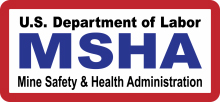Advances in safety management lowers fatality rate
 Safety in metal and nonmetal mines in the first three months of 2016 improved over 2015 – and last year was a record year for fatality reduction in mining.
Safety in metal and nonmetal mines in the first three months of 2016 improved over 2015 – and last year was a record year for fatality reduction in mining.
It is no accident that there are fewer accidents. There have been encouraging advances in safety management, as perennial hazards are being recognized and counteracted.
Supervisor safety training has improved. Supervisors better understand the value of continuously reinforcing safety consciousness in crew members. They are monitoring better to stop bad practices. They insist employees use the right tools for jobs they are doing. They remind employees about inevitable unexpected work complications that often require rethinking and changing procedures or tools.
Countless accidents happen when employees fail to stop and evaluate. Careful consideration can prevent deadly consequences.
Supervisors, more than anyone else, are positioned to protect crew members from deadly mistakes. That is a lot of responsibility, and the only way to appreciate the results is seeing employees go home safe. Nothing is worse than death or serious injury.
In the first quarter of 2016, three fatal metal and nonmetal mining accidents occurred. Two took place at sand pits and one took place at a surface stone mine.
In a sand pit accident, a 1,750-lb. pipe rolled off the driver’s side and fatally struck a truck driver after a forklift removed two 50-ft. pipes from the passenger side of a flatbed. In another pit accident, a haul truck backed over a dumpsite, turning a routine procedure into a fatality.
In a surface stone mine, a lead man parked his pickup 1,200 ft. from a blast area to protect against unauthorized access, but flyrock struck him.
Pending investigation results, the Mine Safety & Health Administration’s preliminary fatalgrams include recommended best practices for the activities involved. They can be summarized as follows:
Unloading
- Analyze the risks of massive weight shifting before unstrapping.
- Make sure access is controlled and no one is exposed to unexpected movement.
- Install secondary supports (side stakes) to prevent movement during off-loading.
- Firmly secure items to off-loading machines.
- Block pipes wherever they’re deposited to prevent rolling.
Dumping
- Inspect ground at dump sites before work and as conditions change.
- Train drivers and others at dump sites to recognize hazards.
- Do not back trucks at an angle.
- Dump short of edges and push material over with a dozer.
- Monitor frequently for safe procedures and seat belt use.
Blasting
- Use technology to evaluate geology and implement site-specific blast plans.
- Monitor drill logs for ground variations and irregularities.
- Make sure loading takes into account variances in burden.
- Adjust stemming, decking accordingly.
- Ensure ample calculation of blast area and flyrock exposure.
Supervisor Support
Workers make mistakes. But, if a supervisor asks questions, workers think twice. With heavy pipe, there is always a potential for accidents. The same is true for dumping and blasting. These are recurring mining industry hazards. They have repeatedly cost the lives of mine employees and outside contractors. Extraordinary caution is necessary in these areas.
Prevention can come from supervisors’ habitually insisting that before workers start a job – particularly something out of the ordinary – that they stop, evaluate and make a plan to be safe. You never know the life you save, as the saying goes, but if an accident occurs you will never forget it.
In the past, the first reaction after an accident was often: How could the employee do such a thing? Today, there is increased recognition that employers can do much to prevent “such a thing.”
Employees often suffer accidents because they are motivated in their job. They want to get a project done and move on. Precautions may seem unnecessary.
Sometimes, workers want to take shortcuts and, too often, these are risky. Workers do not imagine something bad will happen, but supervisors can help them to imagine.
There are no statistics to inform supervisors of their safety successes, but with today’s reduction in accidents, they need to recognize the good work they are doing, and that they are saving lives.
Michael T. Heenan is with the national labor, employment and safety law firm Ogletree Deakins. His book MSHA Compliance Essentials is available in English and Spanish (2016). Email him at michael.heenan@odnss.com.









